传统的猪场废弃物是农田土壤有机质、氮、磷、钾等的重要来源。但随着规模化养殖的发展,尤其是高铜、锌饲料添加剂的施用,导致猪场废弃物Cu、Zn含量较高[1-3]。据调查,猪粪Cu含量为10.7~1591 mg·kg-1,Zn含量为71.3~8710 mg·kg-1[4];沼液Cu含量为1.3~11.2 mg·L-1,Zn含量为10.2~33.3 mg·L-1;沼渣Cu含量为1103~3315 mg·kg-1,Zn为3552~14 222 mg·kg-1[5]。因此,畜禽粪便有机肥的施用是造成我国农田土壤重金属污染的重要原因[6-8]。农业农村部《到2020年化肥使用量零增长行动方案》要求60%的畜禽粪便养分还田,规模化养猪已占养猪行业70%的份额,实现规模化猪场废弃物的安全还田对完成该任务具有重要意义。
沼液对不同土壤、不同作物的Cu、Zn含量的影响不同[9-12];沼渣或降低东南景天Cu、Zn含量,或提高黄瓜Cu、Zn含量[13-14];猪粪或降低水稻Cu、Zn含量,或增加了空心菜、小白菜地上部Cu和Zn含量[15-16]。上述猪场废弃物(沼液、沼渣和猪粪)均来自不同猪场,场地来源可能是上述猪场废弃物提高或降低土壤和作物Cu、Zn含量的重要因素,因为不同猪场的废弃物组成有很大差异[17]。那么来自同一猪场的沼液、沼渣和猪粪对土壤和作物Cu、Zn含量的影响如何?目前报道很少。为此,本文同时采集同一规模化猪场的猪粪、沼液和沼渣,施用到菜地土壤,比较猪粪、沼液和沼渣对土壤-生菜系统中土壤有效态Cu、Zn含量和生菜Cu、Zn含量的影响,为富含Cu、Zn猪场废弃物的施用提供基础数据,进而指导猪场废弃物的分类管理及其应用。
1 材料和方法 1.1 供试土壤供试土壤采自广州市番禺区钟村镇,系由坡积物发育而来的普通肥熟旱耕人为土(Typic Fimi-orthic Anthrosols)。取0~20 cm,风干,过1 cm筛,备用。土壤的部分性状如下:pH 6.34,有机质19.3 g·kg-1,全氮1.50 g·kg-1,碱解氮484 mg·kg-1,有效磷114 mg·kg-1,速效钾418 mg·kg-1,Cu全量60.9 mg·kg-1,Zn全量125 mg·kg-1,DTPA-Cu 4.84 mg·kg-1,DTPA-Zn 43.2 mg·kg-1。可见该土壤Cu全量超过农用地土壤污染风险筛选值50 mg·kg-1,Zn全量低于农用地土壤污染风险筛选值(200 mg·kg-1)[18],该土壤为Cu风险土壤。
1.2 供试猪场废弃物供试猪场废弃物(猪粪、沼渣、沼液),于2013年1月22日采自广东省惠州市博罗县某规模化养猪场,风干猪粪和沼渣、粉碎过2 mm尼龙筛,待用。猪粪、沼渣的pH值分别为7.23、8.02,全N含量分别为19.4、33.3 g·kg-1,全P含量分别为4.63、19.3 g·kg-1,全K含量分别为19.4、33.3 g·kg-1,全Cu含量分别为46.2、114 mg·kg-1,全Zn含量分别为1.05、2.57 g·kg-1;沼液的pH值为7.51,沼液的全N、全P、全K含量分别为0.54、0.084、0.24 g·L-1,全Cu、全Zn含量分别为2.64、12.7 mg·L-1。猪场废弃物Cu、Zn含量达到我国现行的农业行业有机肥料标准[19]。
1.3 供试生菜供试生菜品种为半卷叶型的意大利耐抽苔生菜(Lactuca sativa Linn. var. ramosa Hort.),全年可以在广州地区生长。本试验连续种植2茬。
1.4 试验设计盆栽试验设置:不施肥对照(CK),化肥对照(代号F。其中N 0.2 g·kg-1,P2O5 0.08 g·kg-1,K2O 0.16 g·kg-1,分别以尿素、CaH2PO4、K2SO4施入),不同种类和用量的猪场废弃物处理[均不施化肥,分别按N总用量0.1、0.2、0.3、0.4、0.5、0.6 g·kg-1土壤计算3种猪场废弃物用量,其中6个沼液处理水平(740、1480、2220、2960、3700、4440 mL·盆-1,处理号分别为:S1、S2、S3、S4、S5、S6),6个猪粪处理水平(20、40、60、80、100、120 g·盆-1,处理号为:M1、M2、M3、M4、M5、M6),6个沼渣处理水平(12、24、36、48、60、72 g·盆-1,处理号为:R1、R2、R3、R4、R5、R6),计18个处理];共计20个处理,每处理4次重复,共80盆。每盆土壤4 kg。猪粪和沼渣进行基施;分别称取每盆所需土壤和猪粪或沼渣,合并一起混合均匀后装入塑料盆(底径15 cm、口径22 cm、高17 cm)。沼液进行基施+追施;基施沼液量为总量的40%;基施或追施沼液时,处理S6直接用沼液浇灌,S1~S5处理的沼液用自来水稀释到S6体积后浇灌;追施沼液时以称重法确定处理S6的沼液体积;对沼液处理而言,追施完所有沼液后才浇水。称重法浇水,土壤含水量保持在60%左右的田间持水量。2013年4月2日,每盆种植10颗饱满一致、10%H2O2消毒的生菜种子,2013年4月12日间苗至4株生菜幼苗,2013年5月15日收获第1茬;第2茬所有处理不再施化肥或猪场废弃物,2013年5月18日在每盆再播种10颗饱满一致、消毒的生菜种子,间苗及浇水方式与第1茬相同,2013年7月4日收获第2茬。
1.5 样品采集和处理收获生菜可食部分,自来水将生菜冲洗干净,去离子水泡洗2次,擦干表面水分,记录鲜质量后用塑料打浆机匀浆制成鲜样,称取10.00 g鲜样于三角瓶中(同时称取0.5 g蔬菜标准样品进行质量监控)、加入10.0 mL混酸(体积比HNO3:HClO4=9:1,优质纯试剂)消煮、定容到25 mL,日本产火焰原子吸收分光光度计(Hitachi ZA3000)测定消解液中Cu、Zn浓度。收获生菜时同步采集土壤,自然风干,过1 mm尼龙筛,称取10 g土壤,加入50 mL的DTPA溶液[0.005 mol·L-1二乙基三胺五乙酸(DTPA)+0.01 mol·L-1 CaCl2+ 0.1 mol·L-1三乙醇胺(TEA)],摇床上浸提1 h、过滤,火焰原子吸收分光光度计(Hitachi ZA3000)测定滤液中Cu、Zn浓度。
1.6 数据处理和统计数据采用Excel 2003处理,SPSS 10.0进行多重比较(LSD法)、相关性、双因素方差分析、t检验等统计(差异显著水平为P < 0.05)。
2 结果与分析 2.1 生菜可食部分生物量猪场废弃物处理对生菜可食部分生物量有显著影响(图 1)。经双因素方差分析,猪场废弃物种类及其处理水平都显著影响生菜可食部分生物量,二者有交互作用,但猪场废弃物处理水平对生菜可食部分生物量的影响大于废弃物种类。经t检验,第2茬生菜可食部分生物量显著低于第1茬。
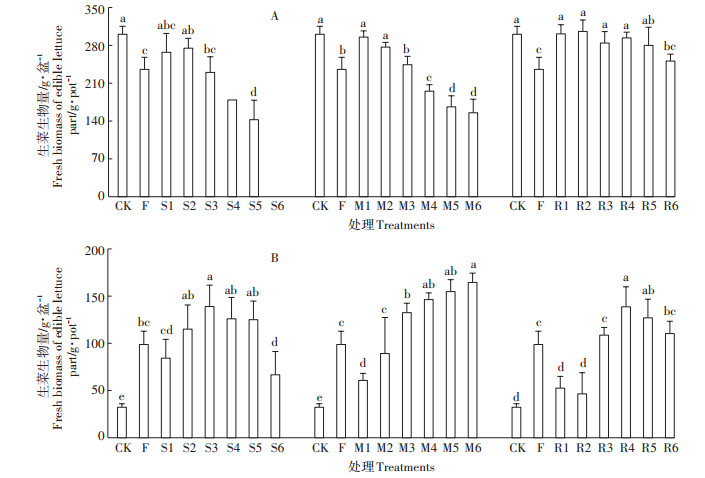
|
图中不同小写字母表示通过LSD法在0.05水平处理间差异显著(A为第1茬,B为第2茬)。下同 Different lowercase letters indicate significant differences among treatments through LSD test at 0.05 level (A for the 1st crop, B for the 2nd crop). The same below 图 1 生菜可食部分鲜质量 Figure 1 Fresh biomass of the edible lettuce part |
第1茬生菜可食部分Cu含量范围0.54~1.97 mg·kg-1,第2茬为0.46~2.08 mg·kg-1。图 2可见,随猪场废弃物种类或处理水平、生菜茬别的不同,生菜Cu含量不同。与F处理(或CK)相比,猪场废弃物提高第1茬生菜Cu含量(图 2A),降低第2茬生菜Cu含量(图 2B);双因素方差分析表明,猪场废弃物种类对生菜Cu含量的影响大于其处理水平。另外,仅沼渣处理第1茬生菜Cu含量与其处理水平呈显著正相关(相关系数为0.557,n=24,P < 0.01)。t检验表明,第1茬生菜Cu含量显著高于第2茬(P < 0.05)。
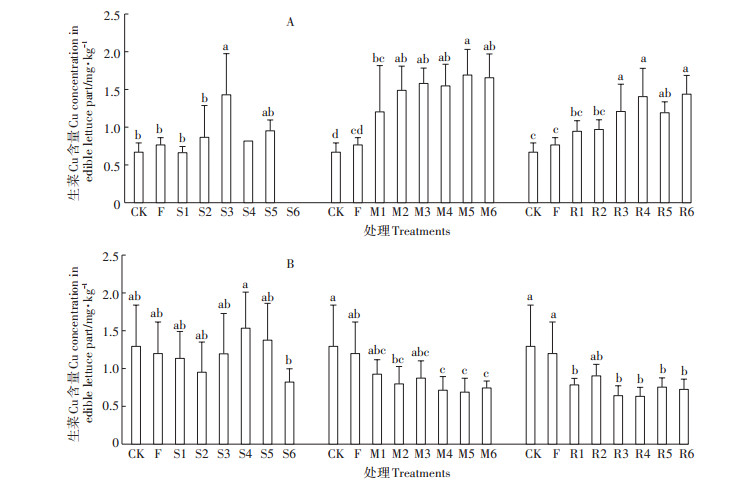
|
图 2 生菜可食部分Cu含量 Figure 2 Cu concentration in the edible lettuce part |
第1茬生菜可食部分Zn含量范围0.70~2.28 mg·kg-1,第2茬为5.26~14.4 mg·kg-1。与生菜Cu含量类似,生菜Zn含量也随废弃物种类、处理水平或生菜茬别的不同而不同(图 3)。与化肥对照F处理相比,猪场废弃物显著降低第1、2茬生菜Zn含量(图 3);双因素方差分析表明,猪场废弃物种类对生菜Zn含量的影响大于其处理水平。另外,第1茬生菜Zn含量分别与沼液、猪粪或沼渣的处理水平显著正相关(相关系数分别为0.842、0.796、0.929,n=24,P < 0.01),第2茬生菜Zn含量与猪粪处理水平显著负相关(相关系数为-0.433,n=24,P < 0.05)、与沼液或沼渣处理水平没有显著相关性。经t检验,第2茬生菜Zn含量显著高于第1茬(P < 0.01)。
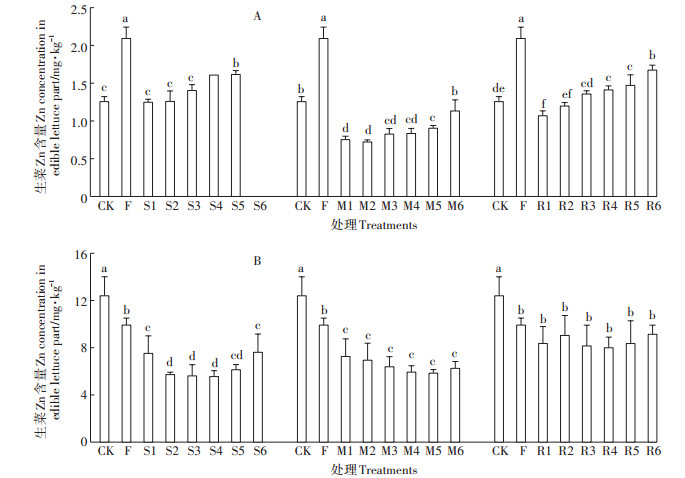
|
图 3 生菜可食部分Zn含量 Figure 3 Zn concentration in the edible lettuce part |
猪粪和沼渣处理土壤的DTPA-Cu含量分别随其处理水平增大而显著提高;在相同的N总量处理水平下,沼渣处理土壤的DTPA-Cu含量大于猪粪处理,猪粪处理大于沼液处理(图 4)。沼液、猪粪或沼渣处理第1茬土壤DTPA-Cu含量分别与其处理水平存在显著的正相关关系[相关系数分别为0.450(n=24,P < 0.05)、0.992(n=24,P < 0.01)、0.993(n=24,P < 0.01)];猪粪和沼液处理第2茬土壤的DTPA-Cu含量仍分别与其处理水平显著正相关(相关系数分别为0.933、0.976,n=24,P < 0.01)。第1茬土壤的DTPA-Cu含量与第2茬的也显著正相关(相关系数为0.971,n=80,P < 0.01),但t检验二者没有显著差异。
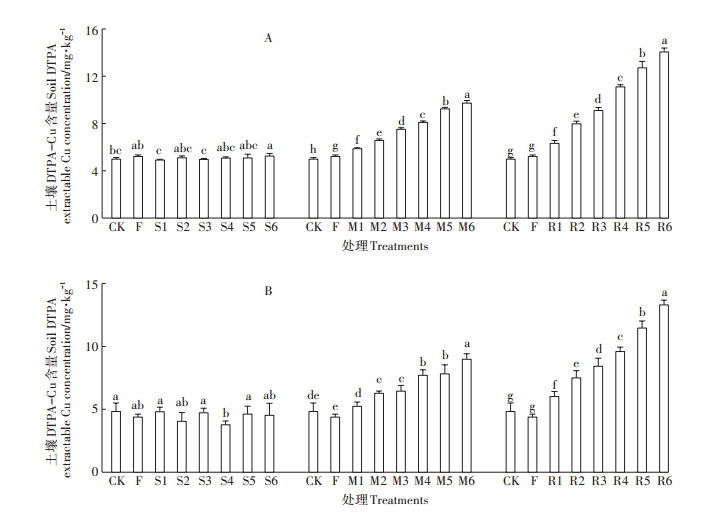
|
图 4 土壤DTPA-Cu含量 Figure 4 Soil DTPA extractable Cu concentration |
猪粪和沼渣处理土壤的DTPA-Zn含量分别随其处理水平增大而显著增加;在相同的N总量处理水平下,沼渣处理土壤的DTPA-Zn含量大于猪粪处理,猪粪处理大于沼液处理(图 5)。沼液、猪粪和沼渣处理第1、2茬土壤DTPA-Zn含量分别与其处理水平存在显著的正相关关系[第1茬相关系数分别为0.937(n=24,P < 0.01)、0.942(n=24,P < 0.01)、0.976(n= 24,P < 0.01);第2茬相关系数分别为0.419(n=24,P < 0.05)、0.967(n=24,P < 0.01)、0.975(n=24,P < 0.01)]。第1茬土壤的DTPA-Zn含量与第2茬的也显著正相关(相关系数为0.970,n=80,P < 0.01),t检验二者没有显著差异。
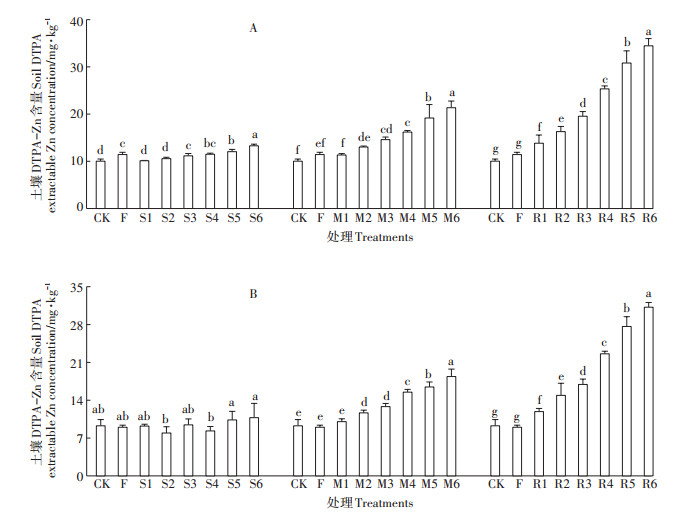
|
图 5 土壤DTPA-Zn含量 Figure 5 Soil DTPA extractable Zn concentration |
猪饲料中添加较多微量营养元素Cu、Zn后,能提高生猪的日增重和料重比,减少猪腹泻[20-23]。猪消化系统对饲料Cu、Zn未能全部吸收甚至有一定的“浓缩效应”,导致猪粪Cu、Zn含量比猪饲料更高,此外,因饲料添加剂含一定量的Cd而导致猪粪Cd含量较高[20, 23-26],更加增大了猪粪农田应用的环境风险。英国猪粪Cu、Zn含量最迟在1998年开始大幅度提高,与之相比,我国猪粪Cu、Zn含量大幅度提高的时间稍晚[20, 23],以江苏为例,猪粪Cu、Zn含量大幅度提高的时间是2002年,2008年猪粪Cu、Zn含量分别比1990年提高771%、410%[23]。猪粪Cu、Zn、As、Cr、Cd、Pb、Ni、Hg中,Cu、Zn含量超标最为严重[3]。Cu、Zn含量较高的猪粪施用到农田土壤,引起土壤Cu、Zn全量增加[3, 27-30],连续施用3年猪粪堆肥,土壤Cu、Zn含量分别比试验前提高了31.2%、27.3%[31]。本文施用猪场废弃物后,土壤DTPA-Cu、DTPA-Zn含量提高,该规律与很多文献一致[28-30, 32]。本文施用了不同水平的猪场废弃物,土壤DTPA-Cu、DTAP-Zn含量的增加与猪场废弃物用量显著正相关(沼液的相关性低一些,见图 4、图 5),与李延等[33]和杨军芳等[34]的报道类似。1981年开始施用猪粪的江西红壤长期试验表明,1981—2002年土壤Cu、Zn全量缓慢增加,2002—2010年土壤Cu、Zn全量大幅度提高,因为2002年以后开始施用高Cu、Zn含量的猪粪[30]。由上可知,农田土壤Cu、Zn含量的增加来自猪日粮添加剂;另一方面,堆腐不能降低猪场废弃物中重金属Cu、Zn含量[35],甚至显著提高猪粪Cu、Zn含量[36]。因此,要调控农用土壤Cu、Zn全量,首先应从规范猪日粮添加剂中Cu、Zn用量着手或采取没有环境危害的其他替代措施。
3.2 生菜Cu、Zn含量特征及其影响因素虽然Cu和Zn是生物所必需的微量营养元素,但含量过高又会危害生物。重金属离子中Cu2+的生物毒性最高,且Cu2+的毒性远高于Zn2+毒性[37];土壤外加Cu为50 mg·kg-1时,紫云英根尖扭曲腐烂[38];在Cu、Zn二者对生态环境的影响上,更应关注Cu的影响。本文生菜可食部分Cu含量范围0.50~1.97 mg·kg-1、Zn含量范围0.7~12.9 mg·kg-1,较文献报道的植株Cu含量(3~20 mg·kg-1)和Zn含量(15~300 mg·kg-1)[39]的最小值低,因此,本文生菜中的Cu、Zn含量不会对植株造成伤害。与不施肥对照相比,本试验猪场废弃物对第1茬生菜可食部分Cu含量的影响范围为-0.01~ 1.02 mg·kg-1,对第2茬生菜可食部分Cu含量的影响范围为-0.095~-0.658 mg·kg-1,前后2茬均与王美和李书田[40]统计数据(-0.94~2.5 mg·kg-1)一致。与不施肥对照相比,本试验猪场废弃物对第1茬生菜可食部分Zn含量的影响范围为-0.54~0.41 mg·kg-1,对第2茬生菜Zn含量的影响范围为-3.26~-6.85 mg·kg-1,第1茬与王美等[40]统计的数据(-0.54~15.2 mg·kg-1)一致;但第2茬偏低。第2茬生菜可食部分Cu、Zn含量较不施肥对照低,其原因可能是外加猪场废弃物中可溶性有机质在第2茬时因微生物的矿化而远低于第1茬,其活化Cu、Zn的效应极大降低,另外,第2茬时猪场废弃物中大分子有机物对Cu、Zn的吸附、络合、沉淀等作用有所增强。第2茬生菜可食部分Cu、Zn含量随猪粪、沼渣的用量增加而降低,与文献报道猪粪、沼渣降低生菜可食部分Cd含量的趋势一致[24]。本试验第1茬生菜可食部分Cu、Zn含量与猪粪或沼渣用量显著正相关、与土壤DTPA-Cu、DTPA-Zn含量显著正相关,文献报道与之一致[33-34];第2茬生菜可食部分Cn、Zn含量与土壤DTPA-Cu、DTPA-Zn含量没有显著相关性,也得到文献支持[41]。
另外,由于植物对Zn的吸收,受土壤类型、pH、有机质、湿度、N含量、P含量、Cu含量、Mn含量、作物种类等多种因素的影响,本试验化肥处理的第1茬生菜可食部分Zn含量远高于其他处理,可能主要与该处理土壤pH值最低有关(土壤pH值未列出)。本文第1、2茬生菜Cu或Zn含量差异大,其实质的影响因素包括:前后2茬土壤的营养供给水平,影响前后2茬生菜Cu、Zn吸收的阴阳离子消长,影响土壤水活度及重金属活度的温差等,限于本文试验设计,这些影响因素还不能揭示,需要后续试验来探索。
3.3 猪场废弃物的安全施用虽然沼液中Cu、Zn含量较沼渣和猪粪低,对土壤Cu、Zn含量的贡献量小,但从第1茬S6处理的生菜生物量来看,沼液不宜直接施用到蔬菜(沼液应兑水,分次施)。根据供试生菜生长状况,本试验土壤上沼液的最佳施用量是370 mL·kg-1,猪粪的最佳施用量是10 g·kg-1,沼渣的最佳施用量是6 g·kg-1(每公顷土壤以4500 t计,即沼液、猪粪、沼渣的公顷用量分别为1665 m3、45 t、27 t,猪粪和沼渣基施)。每年以本试验最佳用量10 g·kg-1施入猪粪,相当于每年土壤外加Cu含量为0.462 mg·kg-1,土壤外加Cu总量达50 mg·kg-1约需要100年,可见土壤Cu含量增加很缓慢,但如果每年以50 g·kg-1(每公顷225 t猪粪)施入猪粪,土壤外加Cu 50 mg·kg-1只需要20年,Qian等[42]通过4年田间试验也得出土壤Cu超标的年限为15年。由此可知,通过控制富含Cu、Zn的猪场废弃物施用到农田土壤的总量或频率来降低其对生态环境的危害。虽然本试验供试土壤Cu含量已经超过了农用地土壤污染风险筛选值(50 mg·kg-1),但施用猪场废弃物后生菜Cu含量仍然较低,因此,供试土壤还具有一定的猪场废弃物的消纳能力。不过,Cu、Zn含量较高的猪场废弃物,施用到缺Cu土壤可能更合适[43-44],广东、四川、陕西和黑龙江4省是我国缺Cu土壤的主要集中区[45],可以消纳大量的富含Cu、Zn的猪场废弃物。
4 结论猪场废弃物种类及其处理水平均显著影响生菜生物量;同时也均显著影响生菜Cu、Zn含量(影响大小为猪场废弃物种类 > 其处理水平)。猪场废弃物提高第1茬生菜Cu含量,但降低第2茬Cu含量,影响大小为猪粪 > 沼渣 > 沼液;猪场废弃物降低了2茬生菜Zn含量,影响大小为猪粪 > 沼液 > 沼渣。
废弃物种类对土壤DTPA-Cu或DTPA-Zn含量影响较处理水平大;相同N总量处理下,土壤DTPACu或DTPA-Zn含量呈现沼渣处理 > 猪粪处理 > 沼液处理;沼渣与猪粪处理的土壤DTPA-Cu或DTAP-Zn含量均有显著的剂量效应。
供试土壤还能消纳少量猪场废弃物,缺Cu土壤也能消纳富含Cu、Zn的猪场废弃物。
| [1] |
赵明, 陈雪辉, 赵征宇, 等. 鸡粪等有机肥料的养分释放及对土壤有效铜、锌、铁、锰含量的影响[J]. 中国生态农业学报, 2007, 15(2): 47-50. ZHAO Ming, CHEN Xue-hui, ZHAO Zheng-yu, et al. Releasing of N, P and K of organic fertilizers and their effects on the contents of available Cu, Zn, Fe and Mn in soil[J]. Chinese Journal of Eco-Agriculture, 2007, 15(2): 47-50. |
| [2] |
姜萍, 金盛杨, 郝秀珍, 等. 重金属在猪饲料-粪便-土壤-蔬菜中的分布特征研究[J]. 农业环境科学学报, 2010, 29(5): 942-947. JIANG Ping, JIN Sheng-yang, HAO Xiu-zhen, et al. Distribution characteristics of heavy metals in feeds, pig manures, soils and vegetables[J]. Journal of Agro-Environment Science, 2010, 29(5): 942-947. |
| [3] |
赵睿, 吴智书, 罗阳, 等. 猪粪与农田土壤中重金属累积污染的相关分析[J]. 土壤, 2017, 40(4): 753-759. ZHAO Rui, WU Zhi-shu, LUO Yang, et al. Correlation analysis of heavy metals accumulation pollution in pig manure and farmland soil[J]. Soils, 2017, 40(4): 753-759. |
| [4] |
张树清, 张夫道, 刘秀梅, 等. 规模化养殖畜禽粪主要有害成分测定分析研究[J]. 植物营养与肥料学报, 2005, 11(6): 822-829. ZHANG Shu-qing, ZHANG Fu-dao, LIU Xiu-mei, et al. Determination and analysis on main harmful composition in excrement of scale livestock and poultry feedlots[J]. Plant Nutrition and Fertilizer Science, 2005, 11(6): 822-829. DOI:10.3321/j.issn:1008-505X.2005.06.019 |
| [5] |
陆若辉, 孔海民. 铜锌含量对沼液沼渣资源化利用的制约作用[J]. 浙江农业科学, 2017, 58(9): 1638-1639. LU Ruo-hui, KONG Hai-min. Restriction of copper and zinc in biogas-slurry/-residue against its resource utilization[J]. Zhejiang Agricultural Sciences, 2017, 58(9): 1638-1639. |
| [6] |
许浩, 韩丽媛, 茹淑华, 等. 不同有机肥中Cu、Zn在农田土壤中的有效性与形态归驱[J]. 植物营养与肥料学报, 2016, 22(4): 998-1009. XU Hao, HAN Li-yuan, RU Shu-hua, et al. Bioavailability and form tendency of Cu and Zn in farmland soils after application of different organic fertilizers[J]. Journal of Plant Nutrition and Fertilizer, 2016, 22(4): 998-1009. |
| [7] |
Guo T, Lou C L, Zhai W W, et al. Increased occurrence of heavy metals, antibiotics and resistance genes in surface soil after long-term application of manure[J]. Science of the Total Environment, 2018, 635: 995-1003. DOI:10.1016/j.scitotenv.2018.04.194 |
| [8] |
Wang M L, Liu R H, Lu X Y, et al. Heavy metal contamination and ecological risk assessment of swine manure irrigated vegetable soils in Jiangxi Province, China[J]. Bulletin of Environmental Contamination and Toxicology, 2018, 100(5): 634-640. DOI:10.1007/s00128-018-2315-7 |
| [9] |
黄界颖, 伍震威, 高连芬, 等. 沼液对土壤质量及小白菜产量品质的影响[J]. 安徽农业大学学报, 2013, 40(5): 849-854. HUANG Jie-ying, WU Zhen-wei, GAO Lian-fen, et al. Effects of biogas slurry on soil quality and yield quality of Chinese cabbage[J]. Journal of Anhui Agricultural University, 2013, 40(5): 849-854. |
| [10] |
陈正杰, 张馨蔚, 陈玉成. 沼液灌溉对紫色土-水稻系统的影响研究[J]. 中国沼气, 2013, 31(5): 32-35. CHEN Zheng-jie, ZHANG Xin-wei, CHEN Yu-cheng. Effect of biogas slurry irrigation on purple soil system for rice planting[J]. China Biogas, 2013, 31(5): 32-35. DOI:10.3969/j.issn.1000-1166.2013.05.007 |
| [11] |
杨军芳, 冯伟, 贾良良, 等. 追施沼液对白菜及土壤重金属含量的影响[J]. 河北农业科学, 2015, 19(5): 68-73. YANG Jun-fang, FENG Wei, JIA Liang-liang, et al. Effects of topdressing biogas slurry on the content of heavy metals in Chinese cabbage and soil[J]. Journal of Hebei Agricultural Sciences, 2015, 19(5): 68-73. |
| [12] |
侯时季, 李涛, 蔺阁, 等. 施用沼液和接种丛枝菌根真菌对甘草生长及重金属累积的影响[J]. 农业环境科学学报, 2016, 35(8): 1465-1472. HOU Shi-ji, LI Tao, LIN Ge, et al. Effects of biogas slurry and AM fungi on growth and heavy metal accumulation of licorice plants[J]. Journal of Agro-Environment Science, 2016, 35(8): 1465-1472. |
| [13] |
姚桂华, 徐海舟, 朱林刚, 等. 不同有机物料对东南景天修复重金属污染土壤效率的影响[J]. 环境科学, 2015, 36(11): 4268-4276. YAO Gui-hua, XU Hai-zhou, ZHU Lin-gang, et al. Effects of different kinds of organic materials on soil heavy metal phytoremediation efficiency by Sedum alfredii Hance[J]. Environmental Science, 2015, 36(11): 4268-4276. |
| [14] |
杨军芳, 史建硕, 黄少辉, 等. 施用沼渣对设施黄瓜及土壤重金属含量的影响[J]. 河北农业科学, 2017, 21(4): 82-86. YANG Jun-fang, SHI Jian-shuo, HUANG Shao-hui, et al. Effects of application of biogas residue on greenhouse cucumber and heavy metal contents in soil[J]. Journal of Hebei Agricultural Sciences, 2017, 21(4): 82-86. |
| [15] |
王琼瑶, 李森, 周玲, 等. 猪粪-秸秆还田对土壤、作物重金属铜锌积累及环境容量影响研究[J]. 农业环境科学学报, 2016, 35(9): 1764-1772. WANG Qiong-yao, LI Sen, ZHOU Ling, et al. Accumulation and environmental capacity of Cu and Zn in soil-crop with swine manure applying and straw returning[J]. Journal of Agro-Environment Science, 2016, 35(9): 1764-1772. |
| [16] |
颜蒙蒙, 贾武霞, 苏世鸣, 等. 猪粪中铜、锌与等量水溶性盐对两种叶类蔬菜的植物有效性比较[J]. 农业环境科学学报, 2018, 37(2): 223-321. YAN Meng-meng, JIA Wu-xia, SU Shi-ming, et al. Phytoavailability comparison of Cu and Zn in two types of leaf vegetables after application with manure and the equivalent water-soluble salts[J]. Journal of Agro-Environment Science, 2018, 37(2): 223-321. |
| [17] |
张家才, 胡荣桂, 雷明刚, 等. 畜禽粪便无害化处理技术研究进展[J]. 家畜生态学报, 2017, 38(1): 85-90. ZHANG Jia-cai, HU Rong-gui, LEI Ming-gang, et al. Research progress on innocuous treatment technique of livestock and poultry manure[J]. Acta Ecologiae Animalis Domastici, 2017, 38(1): 85-90. DOI:10.3969/j.issn.1673-1182.2017.01.017 |
| [18] |
生态环境部和国家市场监督管理总局. GB 15618-2018土壤环境质量-农用地土壤污染风险管控标准[S].北京: 中国标准出版社, 2018. Ministry of Ecology and Environment of PRC and State Administration for Market Regulation. GB 15618-2018 Soil environmental quality-Risk control standard for soil contamination of agricultural land[S]. Beijing: China Standards Press, 2018. |
| [19] |
中华人民共和国农业部. NY525-2012有机肥料[S].北京: 中国标准出版社, 2012. Ministry of Agriculture of PRC. NY525-2012 Organic fertilizer[S]. Beijing: China Standards Press, 2012. |
| [20] |
Nicholson F A, Chambers B J, Williams J R, et al. Heavy metal contents of livestock feeds and animal manures in England and Wales[J]. Bioresource Technology, 1999, 70(1): 23-31. DOI:10.1016/S0960-8524(99)00017-6 |
| [21] |
许梓荣, 吴新民. 不同化学形式的铜对仔猪生长、消化和胴体组成的影响[J]. 动物营养学报, 1999, 11(3): 29-35. XU Zi-rong, WU Xin-min. The effects of inorganic or organic copper on growth performance, digestion and carcass composition of weanling piglets[J]. Acta Zoo Nutrimenta Sinica, 1999, 11(3): 29-35. |
| [22] |
许梓荣, 王敏奇. 高剂量锌促进猪生长的机理探讨[J]. 畜牧兽医学报, 2001, 32(1): 11-17. XU Zi-rong, WANG Min-qi. Approach of the mechanism of growthpromoting effect of pharmacological level of zinc in pigs[J]. Acta Veterinariaet Zootechnica Sinica, 2001, 32(1): 11-17. DOI:10.3321/j.issn:0366-6964.2001.01.003 |
| [23] |
Wang H, Dong Y H, Yang YY, et al. Changes in heavy metal contents in animal feeds and manures in an intensive animal production region of China[J]. Journal of Environmental Sciences, 2013, 25(12): 2435-2442. DOI:10.1016/S1001-0742(13)60473-8 |
| [24] |
唐明灯, 李盟军, 王艳红, 等. 猪场废弃物对Cd超标土壤生菜生长及Cd含量的影响[J]. 农业环境科学学报, 2016, 35(3): 558-564. TANG Ming-deng, LI Meng-jun, WANG Yan-hong, et al. Effects of pig farm wastes on growth and Cd concentrations of lettuce grown in a cadmium polluted soil[J]. Journal of Agro-Environment Science, 2016, 35(3): 558-564. |
| [25] |
刘荣乐, 李书田, 王秀斌, 等. 我国商品有机肥料和有机废弃物中重金属的含量状况与分析[J]. 农业环境科学学报, 2005, 24(2): 392-397. LIU Rong-le, LI Shu-tian, WANG Xiu-bin, et al. Contents of heavy metal in commercial organic fertilizers and organic waste[J]. Journal of Agro-Environmental Science, 2005, 24(2): 392-397. DOI:10.3321/j.issn:1672-2043.2005.02.041 |
| [26] |
谭长银, 吴龙华, 骆永明, 等. 长期施肥条件下黑土镉的积累及其趋势分析[J]. 应用生态学报, 2008, 19(12): 2738-2744. TAN Chang-yin, WU Long-hua, LUO Yong-ming, et al. Cadmium accumulation and its development tendency in black soil under longterm fertilization[J]. Chinese Journal of Applied Ecology, 2008, 19(12): 2738-2744. |
| [27] |
Moral R, Perez-Murcia MD, Perez-Espinosa A, et al. Salinity, organic content, micronutrients and heavy metals in pig slurries from southeastern Spain[J]. Waste Management, 2008, 28(2): 367-371. |
| [28] |
李本银, 汪鹏, 吴晓晨, 等. 长期肥料试验对土壤和水稻微量元素及重金属含量的影响[J]. 土壤学报, 2009, 46(2): 281-288. LI Ben-yin, WANG Peng, WU Xiao-chen, et al. Effect of long-term fertilization experiment on concentration of micronutrients and heavy metals in soil and brown rice[J]. Acta Pedologica Sinica, 2009, 46(2): 281-288. DOI:10.3321/j.issn:0564-3929.2009.02.013 |
| [29] |
李本银, 黄绍敏, 张玉婷, 等. 长期施用有机肥对土壤和糙米铜、锌、铁、锰和镉积累的影响[J]. 植物营养与肥料学报, 2010, 16(1): 129-135. LI Ben-yin, HUANG Shao-min, ZHANG Yu-ting, et al. Effect of long-term application of organic fertilizer on Cu, Zn, Fe, Mn and Cd in soil and brown rice[J]. Plant Nutrition and Fertilizer Science, 2010, 16(1): 129-135. |
| [30] |
李大明, 柳开楼, 黄庆海, 等. 长期施用猪粪红壤稻田土壤Cu、Zn累积规律[J]. 生态学报, 2015, 35(3): 709-716. LI Da-ming, LIU Kai-lou, HUANG Qing-hai, et al. Accumulation dynamic of soil Cu and Zn under long-term application of pig manure in red paddy field[J]. Acta Ecologica Sinica, 2015, 35(3): 709-716. |
| [31] |
黄新灿, 章明奎. 长期施用猪粪源有机肥对蔬菜-土壤系统重金属累积的影响[J]. 农学学报, 2016, 6(4): 30-35. HUANG Xin-can, ZHANG Ming-kui. Long-term application of pig manure compost affecting heavy metal accumulation in vegetable-soil system[J]. Journal of Agriculture, 2016, 6(4): 30-35. |
| [32] |
Xu Q T, Zhang M K. Source identification and exchangeability of heavy metals accumulated in vegetable soils in the coastal plain of eastern Zhejiang Province[J]. Ecotoxicology and Environmental Safety, 2017, 142: 410-416. DOI:10.1016/j.ecoenv.2017.03.035 |
| [33] |
李延, 彭来真, 刘琳琳, 等. 施用猪粪对土壤Cu形态和菜心Cu含量的影响[J]. 热带作物学报, 2010, 31(4): 535-540. LI Yan, PENG Lai-zhen, LIU Lin-lin, et al. Influence of applying swine manure on Cu content of the soil and Brassica campestris[J]. Chinese Journal of Tropical Crops, 2010, 31(4): 535-540. |
| [34] |
杨军芳, 贾良良, 冯伟, 等. 施用沼渣对白菜及土壤重金属含量状况的影响[J]. 华北农学报, 2014, 29(增刊): 322-327. YANG Jun-fang, JIA Liang-liang, FENG Wei, et al. Effect of contents of heavy metals by application of biogas residue in Chinese cabbage and soil[J]. Acta Agriculturae Boreali-Sinica, 2014, 29(Suppl): 322-327. |
| [35] |
赵秋, 孙毅, 吴迪, 等. 猪粪堆制过程中铅、镉、铜、锌的变化[J]. 黑龙江农业科学, 2007, 5: 50-52. ZHAO Qiu, SUN Yi, WU Di, et al. Change of Pb, Cd, Cu and Zn during the pig manure composting[J]. Heilongjiang Agricultural Science, 2007, 5: 50-52. |
| [36] |
尹晓明, 王荣江, 徐潇潇, 等. 猪粪堆肥过程中养分和重金属含量的动态变化[J]. 植物营养学报, 2019. YIN Xiao-ming, WANG Rong-jiang, XU Xiao-xiao, et al. Change of nutrient and heavy metal concentrations during swine composting[J]. Journal of Plant Nutrition and Fertilizer, 2019. DOI:10.11674/zwyf.18044 |
| [37] |
李波, 马义兵, 史奕. 植物毒性评价终点的生物配体模型比较研究[J]. 环境科学与技术, 2016, 39(10): 20-25. LI Bo, MA Yi-bing, SHI Yi. The comparisons of biotic ligand model based on different heavy metals and plant toxicity endpoints[J]. Environmental Science & Technology, 2016, 39(10): 20-25. |
| [38] |
倪才英, 陈英旭, 骆永明. 土壤-植物系统铜污染与修复的研究进展[J]. 浙江大学学报(农业与生命科学版), 2003, 29(3): 237-243. NI Cai-ying, CHEN Ying-xu, LUO Yong-ming. Recent advances in research on copper pollution and remediation of soil-plant system[J]. Journal of Zhejiang University (Agric. & Life Sci.), 2003, 29(3): 237-243. DOI:10.3321/j.issn:1008-9209.2003.03.003 |
| [39] |
唐明灯, 胡锋, 吴龙华, 等. 香薷属植物在重金属修复中的应用进展[J]. 土壤, 2008, 40(5): 698-705. TANG Ming-deng, HU Feng, WU Long-hua, et al. Progresses on phytoremediation of heavy metal contaminated soils using Elsholtzia plants[J]. Soils, 2008, 40(5): 698-705. DOI:10.3321/j.issn:0253-9829.2008.05.004 |
| [40] |
王美, 李书田. 肥料重金属含量状况及施肥对土壤和作物重金属富集的影响[J]. 植物营养学报, 2014, 20(2): 466-480. WANG Mei, LI Shu-tian. Heavy metals in fertilizers and effect of the fertilization on heavy metal accumulation in soils and crops[J]. Journal of Plant Nutrition and Fertilizer, 2014, 20(2): 466-480. |
| [41] |
黄穗虹, 田甜, 邹晓锦, 等. 大宝山矿周边污染土壤重金属生物有效性评估[J]. 中山大学学报(自然科学版), 2009, 48(4): 125-129, 136. HUANG Sui-hong, TIAN Tian, ZOU Xiao-jin, et al. Bioavailability assessment of heavy metals in the vicinity of Dabaoshan mine[J]. Acta Scientiarum Naturalium Universitatis Sunyatseni, 2009, 48(4): 125-129, 136. DOI:10.3321/j.issn:0529-6579.2009.04.025 |
| [42] |
Qian X Y, Wang Z, Shen G X, et al. Heavy metals accumulation in soil after 4 years of continuous land application of swine manure:A field-scale monitoring and modeling estimation[J]. Chemosphere, 2018, 210: 1029-1034. DOI:10.1016/j.chemosphere.2018.07.107 |
| [43] |
唐明灯, 吴龙华, 李宁, 等. 修复植物香薷堆肥对缺铜土壤上冬小麦生长和铜吸收的初步研究[J]. 土壤, 2006, 38(5): 614-618. TANG Ming-deng, WU Long-hua, LI Ning, et al. Prelinimary study on effect of Elsholtzia splendens compost on plant growth and Cu uptake by winter wheat in a Cu-deficient upland soil[J]. Soils, 2006, 38(5): 614-618. DOI:10.3321/j.issn:0253-9829.2006.05.019 |
| [44] |
Tang M D, Hu F, Wu L H, et al. Effects of copper-enriched composts applied to copper-deficient soil on the yield and copper and zinc uptake of wheat[J]. International Journal of Phytoremediation, 2009, 11: 81-93. DOI:10.1080/15226510802363535 |
| [45] |
刘铮, 朱其清, 唐丽华, 等. 我国缺乏微量元素的土壤及其区域分布[J]. 土壤学报, 1982, 19(2): 209-221. LIU Zheng, ZHU Qi-qing, TANG Li-hua, et al. Geographical distribution of trace elements-deficient soils in China[J]. Acta Pedologica Sinica, 1982, 19(2): 209-221. |
 2019, Vol. 38
2019, Vol. 38


